The cherry blossom viewing season is just around the corner! Are you searching for where to see cherry blossoms in Tokyo? In Tokyo, you can relish various types of cherry blossoms every year from late March to early April, including the Yoshino cherry tree, double cherry blossoms, and Gyoikou, which boasts rare green petals.
Here are 11 recommended Tokyo cherry blossom viewing spots, ranging from popular destinations bustling with visitors to hidden gems where you can peacefully enjoy the cherry blossoms.
One of the best ways to explore Tokyo is to visit the local areas and immerse yourself in the local culture. If you want to explore local areas, we have created scavenger hunt adventures personalised to your interests, filled with fun facts, clues and puzzles. If you’re curious, you can check out the games here! Check out the Flip Japan Games here! |
Find out more about Spring in Japan here: What to do in Spring, Where to go in spring, Wisteria in Japan, Spring date ideas, What to eat in spring, Where to see cherry blossom in Tokyo, and Cherry blossom festivals.
Tokyo Cherry Blossom Viewing Spots
1. Meguro River

Meguro River, stretching approximately seven kilometres and flowing into Tokyo Bay via Meguro Ward and Shinagawa Ward, boasts around 800 Yoshino cherry trees lining its four-kilometre length. Many visitors flock to this location for Tokyo cherry blossom viewing, particularly near Nakameguro Station on the Tokyu Toyoko Line and Tokyo Metro Hibiya Line, making it a bustling area during springtime. Besides the standard fare of yakisoba and takoyaki, numerous stalls offer wine and champagne, adding to the festive atmosphere. Indulging in food while admiring the cherry blossoms is a popular pastime in Japan.
For a more leisurely experience of cherry blossoms and cuisine, consider visiting the restaurants and cafes along the riverbank. Due to the popularity of window seats, reservations are highly recommended, so be sure to contact us promptly to secure your spot.
During the cherry blossom season, a 700-metre section from “Tenjinbashi” in Aobadai, Meguro-ku, to “Horaibashi” in Kamimeguro is illuminated, allowing for nighttime cherry blossom viewing. The sight of fully bloomed cherry blossoms against the night sky creates a magical ambiance, further enhanced by the beautiful lanterns adorning both sides of the river.
To escape the crowds and enjoy a peaceful stroll, head downstream towards Meguro Station, where the wide river and well-maintained promenade offer a serene environment for cherry blossom viewing at a leisurely pace.
For a unique perspective of the Meguro River cherry blossoms, consider taking a cherry blossom viewing cruise. The “Meguro River Cherry Blossom Viewing Cruise,” organized by Tokyo Waterways, offers a 70-minute round trip from Tennozu Pier to the Meguro River. Relax aboard the boat as you take in the picturesque scenery of Tokyo along the riverbanks, adorned with blooming cherry blossoms.
2. Chidorigafuchi Ryokudo

About 260 cherry trees, including Somei Yoshino and Oshima cherry trees, adorn the Chidorigafuchi Ryokudo, a 700-metre stretch along the Chidorigafuchi on the west side of the Imperial Palace, perfect for Tokyo cherry blossom viewing. As you stroll along the promenade, cherry blossoms create a canopy overhead, resembling a pink tunnel.
For a unique perspective of Tokyo cherry blossom viewing, consider renting a rowing boat for 2 to 3 people and gliding along the moat to admire the cherry blossoms cascading near the water’s surface. The drooping branches create an illusion of being enveloped in pink clouds.
During the “Chiyoda Sakura Festival,” held from late March to early April, the night illuminations transform the scene, with the Chidorigafuchi Boating Ground open for nighttime exploration. The sight of the illuminated cherry blossoms casting reflections on the water’s surface is truly enchanting. After experiencing the daytime beauty, why not return to soak in the evening ambiance?
3. Shinjuku Gyoen
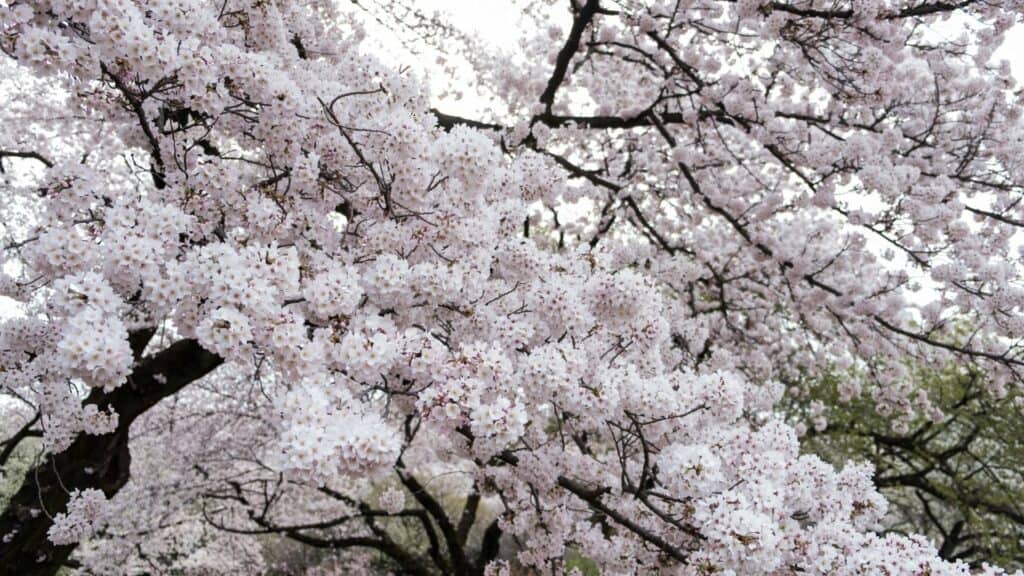
Shinjuku Gyoen offers a picturesque view of the Shinjuku skyscrapers against the backdrop of its meticulously maintained extensive garden. This vast area, spanning approximately 60 hectares (2.471 acres), features distinct gardens including an English landscape garden, a French orthopedic garden, and a traditional Japanese garden, each showcasing beautiful scenery throughout the seasons. Additionally, visitors can explore a stunning greenhouse boasting a variety of tropical flowers.
In addition to the early-blooming Kanzakura, Shinjuku Gyoen is home to about 65 species and 1,000 cherry trees, including Somei Yoshino and Kasumizakura, making it an ideal spot for Tokyo cherry blossom viewing from mid-February to late April.
For an optimal experience, consider visiting in mid-April when the iconic Ichiyo, a representative variety of Yae Sakura in Shinjuku Gyoen, is in full bloom. During this time, the double cherry blossoms are also illuminated, creating a magical atmosphere. Noteworthy varieties such as “Gyoikou,” featuring rare green petals, and “Ukon,” a yellow cherry tree, are also popular among visitors. Spread out a picnic lunch on the spacious lawn and immerse yourself in the beauty of the cherry blossoms.
4. Ueno Onshi Park
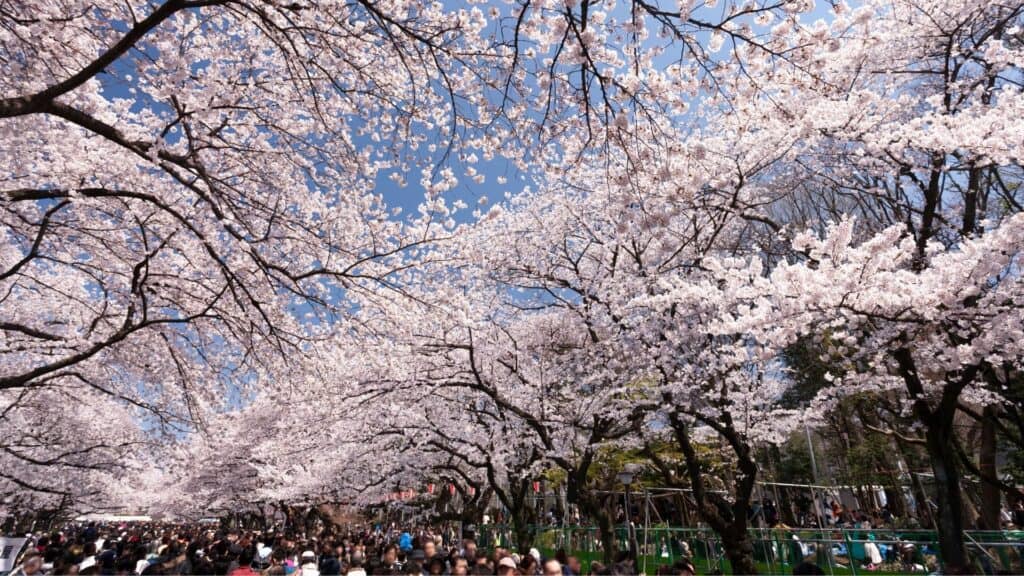
Ueno Onshi Park, a popular destination for Tokyo cherry blossom viewing, attracts numerous visitors every year. This iconic park is famous for its cherry blossoms, which symbolize Tokyo, boasting around 800 cherry trees of approximately 50 species, including Yoshino cherry blossoms and Oshima cherry blossoms.
The annual Ueno Sakura Festival takes place from late March to early April (depending on the cherry blossoms’ flowering status). During this event, around 1,000 lanterns are illuminated at night, enhancing the festive atmosphere (*planned after the cherry blossoms bloom). Visitors can enjoy lively gatherings and banquets held throughout the day and night, making it an ideal outing for friends seeking entertainment.
Within the expansive grounds of the park, visitors can explore attractions such as the popular Ueno Zoo, known for its adorable pandas, and the National Museum of Western Art, which houses works by Le Corbusier, a significant figure in modern architectural history. With a plethora of tourist attractions to explore alongside the cherry blossoms, visitors are encouraged to discover the park’s diverse offerings.
5. Yasukuni Shrine

Yasukuni Shrine is known for having a specimen tree of cherry blossoms that are designated by the Japan Meteorological Agency. The shrine has about 500 cherry trees, like Yoshino cherry trees and wild cherry trees, that warmly welcome visitors. The cherry blossoms that bloom in front of the torii gate and the hall of worship are beautiful. It’s the perfect place to feel the joy of spring.
It is also the place of the “sample cherry tree” of Tokyo. This tree is carefully observed. Once it begins to blossom, Tokyo announces that the cherry blossoms have officially started to bloom. Plus, the shrine’s entrance has temporary food stalls that offer takoyaki, okonomiyaki, and yakisoba.
By the time the cherry blossoms bloom, the “Dedication Yasukuni Shrine Night Cherry Blossom Noh” will be held (tickets required). Set in the Noh theatre, which has had this tradition for more than 130 years. It is fun to spend an elegant night while enjoying the fantastic Takigi noh danced by Noh performers and Kyogen artists.
6. Inokashira Park
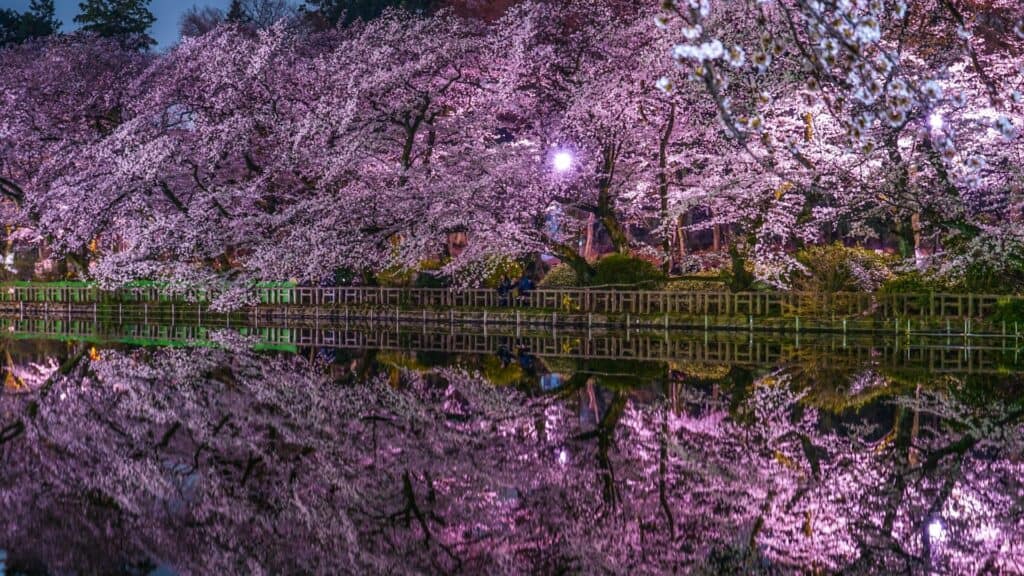
Inokashira Park celebrated its 100th anniversary in 2017. It stands as one of the premier spots for Tokyo cherry blossom viewing and has been honored as one of the “100 Best Cherry Blossom Spots in Japan.”
The park boasts approximately 500 cherry trees, including Yoshino cherry trees and wild cherry trees. However, the main attraction lies in the approximately 250 cherry trees encircling “Inokashira Pond.” The view from the “Nanai Bridge,” positioned at the pond’s center, is particularly popular. Additionally, the sight of cherry blossoms with branches extending near the water’s surface, enveloping the pond area, is truly breathtaking.
While Inokashira Park doesn’t feature illuminations like other locations, visitors can still enjoy the cherry blossoms under the park’s streetlights at night. Despite the subtle lighting, the cherry blossoms exude a mysterious and captivating beauty.
7. Sumida River

The Sumida River flows between Taito Ward and Sumida Ward, adorned with approximately 850 beautiful cherry blossoms such as Somei Yoshino and Oshima cherry trees. These trees embellish both banks of the river, stretching for about 1km from “Sakurabashi” to “Azumabashi.”
The Taito Ward side is favored by Tokyo cherry blossom viewing enthusiasts for its splendid view of the Tokyo Sky Tree alongside the cherry blossoms overlooking the river. Visitors can leisurely stroll along the riverbank, scouting for picturesque spots perfect for capturing memorable photographs.
At Sumida Park, which extends along the Sumida River, the Sumida Park Sakura Festival takes place from late March to early April. As the sun sets, the cherry blossom trees and Bonbori lanterns are illuminated, offering a mesmerizing display of nighttime cherry blossoms.
8. Rikugien

Rikugien is a daimyo garden that epitomizes the Edo period, located just a 7-minute walk from JR Komagome Station. During the spring season, the weeping cherry blossoms and the daimyo garden are illuminated for the Tokyo cherry blossom viewing tradition, scheduled from late March to early April. In the evening, when the cherry blossoms are in bloom, visitors are enveloped in a magical atmosphere.
The weeping cherry blossoms, towering at approximately 15m high and spanning about 20m wide, leave a lasting impression. If the breathtaking view seems too expansive to capture in a single photo frame, it’s definitely worth taking a closer look.
Throughout the light-up period, “Sakura Chaya” offers light meals, while “Matcha Chaya” provides an opportunity to savor matcha and Japanese sweets. Be sure to indulge in the enchanting Tokyo cherry blossom viewing experience amidst the splendid night garden.
9. Showa Kinen Park

Showa Kinen Park boasts 1,500 cherry blossoms of approximately 30 varieties, including Yoshino cherry trees, wild cherry trees, and Kanzan. Spanning an area equivalent to 39 Tokyo Domes, the park is renowned for offering a serene Tokyo cherry blossom viewing experience, free from overcrowding concerns.
Sakura-no-en, within the park, features around 200 cherry blossoms. Here, visitors can unwind beneath a large Yoshino cherry tree, ideal for relaxing on a spread-out sheet. Positioned nearly at the park’s center is a majestic zelkova tree, standing at a towering height of 20m or more, serving as the park’s symbolic tree.
After unwinding, consider taking a leisurely stroll along the Zanbori River, admiring the cherry blossom trees, or opt for a bicycle ride along the cycling road, embracing the gentle breeze.
Annually from the end of March to the end of May, the park hosts the “Flower Festival.” This vibrant event showcases cherry blossoms, tulips, poppies, Adonis ramosa, plums, rape blossoms, wisteria, water lilies, and azaleas in full bloom, enhancing the park’s beauty. Visitors can revel in the arrival of spring as the colorful flowers paint the garden in bright hues.
10. Asukayama Park

Asukayama Park has been a popular destination for cherry blossom viewing since the Edo period. Legend has it that around 300 years ago, approximately 1,200 wild cherry trees were planted as part of the “Kyoho Reform” by Yoshimune Tokugawa, the eighth shogun.
Presently, the park is adorned with approximately 600 cherry trees, including Yoshino cherry trees and Satozakura. The promenade and open spaces can get crowded with visitors strolling and enjoying picnics during Tokyo cherry blossom viewing season.
During the peak of cherry blossom season, the “Kita-ku Sakura SA-KASO Festival” takes place, featuring various events. Additionally, the park illuminates at night, with bonbori lanterns casting a warm glow, providing an enchanting atmosphere for nighttime cherry blossom viewing.
11. Roppongi Hills
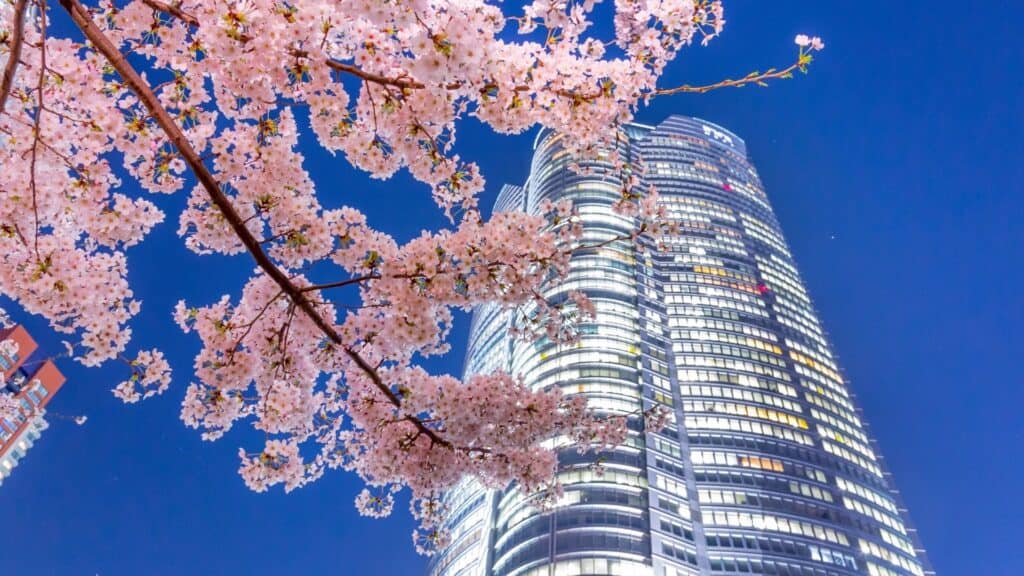
The cherry blossoms at Roppongi Hills, a prominent landmark in Tokyo, are known for their unique charm distinct from other spots. The juxtaposition of skyscrapers and cherry blossoms creates a captivating and exclusive spectacle in the city. The towering 238m-high “Roppongi Hills Mori Tower” stands amidst the cherry blossom trees, exuding a commanding presence.
Furthermore, at the picturesque Japanese garden “Mori Garden” and along “Roppongi Sakurazaka,” extending approximately 400m, around 90 Somei Yoshino cherry trees are illuminated, casting a magical glow over Roppongi at night.
During the “Roppongi Hills Spring Festival” held in early April, visitors can indulge in various attractions such as gourmet food stalls and music/entertainment performances, which are perennial favorites among attendees.
So there you have it! All the best places for Tokyo cherry blossom viewing this year. Whether you choose to wander through the historic Ueno Park, find serenity amidst the lush gardens of Shinjuku Gyoen, or marvel at the modern spectacle of Roppongi Hills, there’s no shortage of beauty to behold during Tokyo cherry blossom viewing season. So as you plan your springtime adventures, be sure to refer to this list for inspiration and enjoy the splendor of cherry blossoms in full bloom across the city.
Find out more about Spring in Japan here: What to do in Spring, Where to go in spring, Wisteria in Japan, Spring Date ideas, What to eat in spring, Where to see cherry blossom in Tokyo, and Cherry blossom festivals.
Stay tuned for more information about Japan travel, Japanese culture, moving to Japan, living in Japan, Japanese language and more.

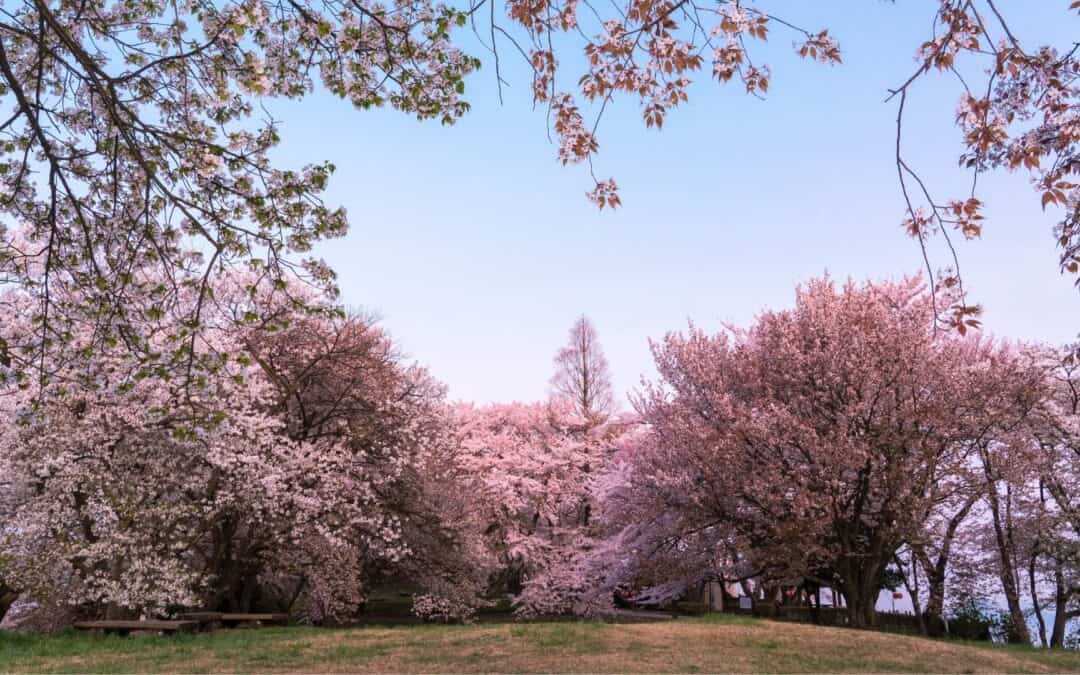
Recent Comments